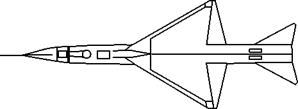Eighth Story
In English Electric’s summary brochure there is a section at the beginning called ‘‘History.’’ Here’s part of the first paragraph: ‘‘Several widely-differing designs for a Canberra replacement aircraft were studied at Warton towards the end of 1956, and, by early 1957, calculations and wind tunnel tests had shown the optimum design to be an aircraft resembling the P.17 configuration. The merits of this configuration were confirmed by further tests, and the design was found to meet G. O.R. 339 requirements as these became known’’ (English Electric 1959). This paragraph is accompanied by three drawings of the P.17A that give an overall view of its geometry (see figure 5.10).
The full brochure offers a more abstract account: ‘‘The design process of a modern aircraft, especially a versatile one, could be summarised as obtaining the best combination of a large number of variables each one of which reacts on many of the others. The final product 110 Heterogeneities must meet each of its requirements roughly in proportion to the em-
|

phasis placed on the relevant role” (English Electric/Short Bros. 1958, 2.1.8). This sentiment echoes those of the government White Paper on procurement that we have already come across:
An aircraft must be treated not merely as a flying machine but as a complete ‘‘weapons system’’. This phrase means the combination of airframe and engine, the armament needed to enable the aircraft to strike at its target, the radio by which the pilot is guided to action or home to base, the radar with which he locates his target and aims his weapons, and all the oxygen, cooling and other equipment which ensure the safety and efficiency of the crew. Since the failure of any one link could make a weapons system ineffective, the ideal would be that complete responsibility for co-ordinating the various components of the system should rest with one individual, the designer of the aircraft. Experience has shown that this is not completely attainable, but it is the intention to move in this direction as far as practical considerations allow. (HMSO 1955, 9)
This was quoted in the previous chapter, but I’m citing it again now because I want to insert it into a different context.










